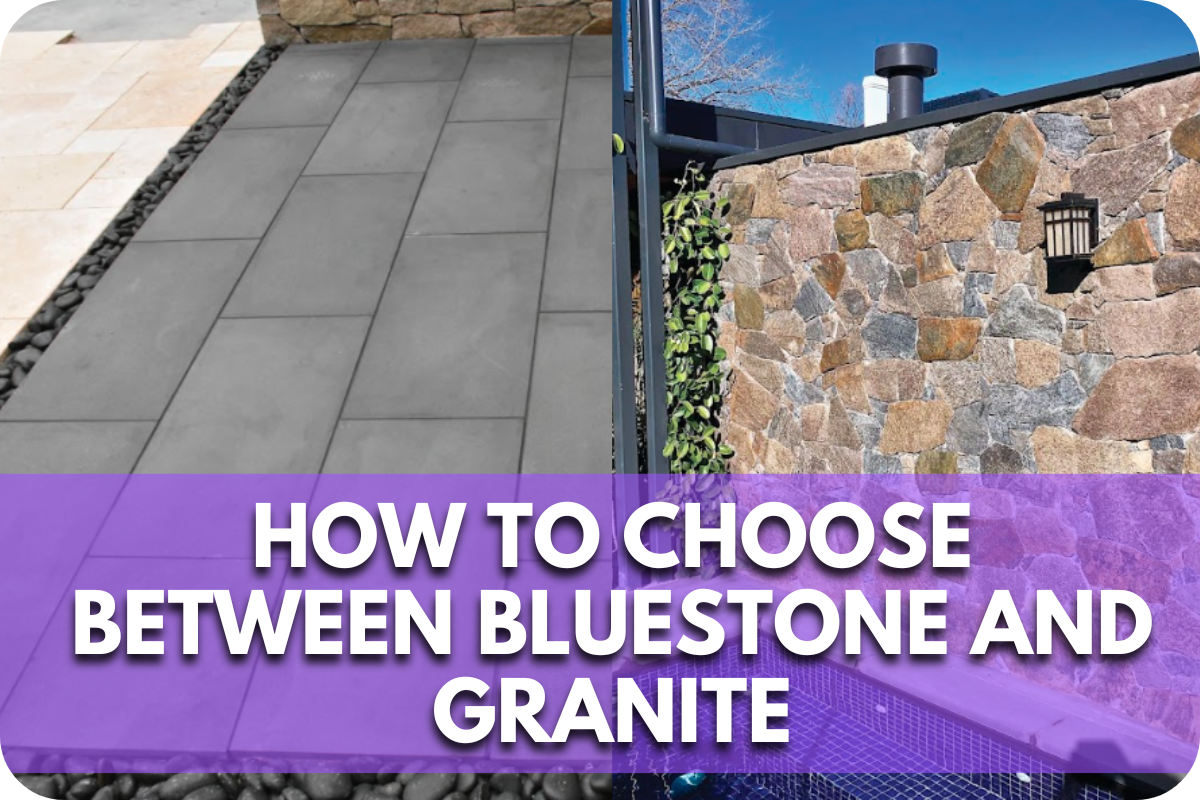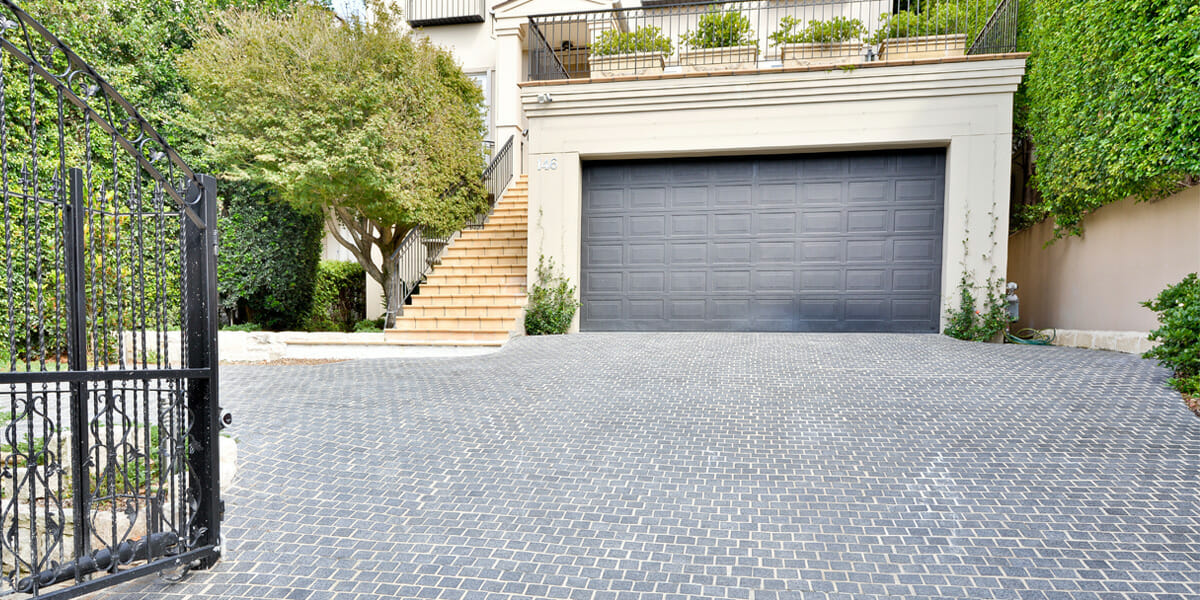
Choosing between bluestone and granite for your next project can be overwhelming.
Both offer unique aesthetics and durability, but their differences can make or break your design.
This guide will break down their pros, cons, and ideal applications to help you make an informed decision.
1. Characteristics
Bluestone Characteristics:
Bluestone is a sedimentary rock known for its rich history and distinctive blue-grey hues. However, depending on the quarry’s location and mineral composition, its colour can vary, ranging from deep blues and greens to lighter greys and even browns.
Bluestone’s surface texture is typically smooth with subtle variations, often showcasing fossil impressions or mineral deposits. It is characterised by its dense composition and natural cleft finish, which give it a non-slip surface ideal for outdoor applications.
Granite Characteristics:
Granite, an igneous rock, is celebrated for its remarkable durability and wide array of colours. It’s available in a vast spectrum, from classic whites and blacks to vibrant reds, blues, and greens.
This diversity is due to the different minerals present during its formation. Granite’s texture can vary from fine-grained to coarse-grained, depending on the cooling rate of the molten rock.
The coarse-grained varieties often exhibit visible crystals, adding visual interest. Granite is known for its polished, sleek finish, making it a popular choice for countertops and interior applications.
2. Common Applications
Bluestone Application
Bluestone is commonly used for outdoor applications due to its natural slip-resistant surface and durability. Popular uses include patios, pathways, and pool surrounds, where its non-slip properties enhance safety.
Bluestone is also a favourite for outdoor stair treads and garden stepping stones. Its natural aesthetic blends seamlessly with the landscape. Its thermal properties make it ideal for areas exposed to direct sunlight, as it remains cool.
Granite Application
Granite, known for its hardness and resistance to wear, is frequently used for indoor and outdoor applications. Indoors, it is a popular choice for kitchen countertops and bathroom vanities, where its resistance to scratching and heat is highly valued.
Granite’s wide range of colours and patterns adds an element of luxury to any space. Outdoors granite is often used for paving, wall cladding, and monuments.
Its ability to withstand harsh weather conditions and high-traffic areas makes it suitable for driveways, pathways, and exterior wall facades.
3. Durability
Bluestone Durability:
Bluestone is renowned for its robust durability, making it a long-lasting choice for various applications. It exhibits excellent resistance to wear, weathering, and freeze-thaw cycles, making it suitable for outdoor use in diverse climates.
Factors such as the stone’s quality, installation method, and maintenance influence its lifespan. Properly installed and sealed bluestone can endure for generations, with some installations lasting over a century.
However, neglecting sealing can leave it susceptible to staining and potential damage over time.
Granite Durability:
Granite boasts exceptional durability and is often considered one of the most challenging natural stones. It’s highly resistant to scratches, chips, heat, and staining, making it a preferred choice for high-traffic areas.
Granite is also virtually impervious to weathering, withstanding harsh elements and temperature fluctuations. Its lifespan is incredibly long, often lasting for the lifetime of a building.
Proper sealing is still recommended to enhance its stain resistance and protect its finish. However, even with minimal maintenance, granite remains a reliable choice for long-term durability.
4. Aesthetic Qualities
Bluestone Aesthetic Qualities:
Bluestone’s visual appeal lies in its earthy elegance and timeless charm. Its natural blue-grey hues evoke a sense of tranquillity and blend seamlessly with various architectural styles, from traditional to contemporary.
The subtle variations in colour and texture create a visually exciting surface that adds depth and character to any space. Bluestone is often associated with rustic and coastal designs, complementing natural landscapes and creating a relaxed ambience.
However, it can also be incorporated into modern settings, adding a touch of warmth and sophistication.
Granite Aesthetic Qualities:
Granite’s aesthetic appeal is characterised by its luxurious appearance and versatility. Its wide range of colours and patterns offers endless design possibilities, allowing it to fit seamlessly into any style.
Whether you prefer a classic, monochromatic look or a bold, statement piece, granite can cater to your preferences. The polished finish of granite enhances its natural beauty, creating a sleek and refined surface that exudes elegance.
It’s often associated with high-end kitchens and bathrooms, but its versatility extends to various applications, including flooring, fireplaces, and outdoor features.
5. Maintenance
Bluestone Maintenance:
Bluestone requires relatively simple maintenance to retain its beauty and longevity. Regular sweeping or hosing off debris is usually sufficient for outdoor installations. For indoor use, a damp mop or cloth with mild detergent can be used for cleaning.
Sealing bluestone, especially for outdoor applications, prevents staining and moisture absorption. Depending on the sealant used and the level of wear, resealing might be necessary every few years.
Avoid acidic or abrasive cleaners, which can damage the stone’s surface. Promptly addressing spills and stains can prevent them from setting in and becoming more challenging to remove.
Granite Maintenance:
Granite is remarkably easy to maintain, requiring minimal effort to keep it looking its best. Regular dusting or wiping with a damp cloth is usually sufficient for daily cleaning.
A mild soap or stone cleaner can be used for deeper cleaning. While granite is naturally stain-resistant, sealing it enhances its resistance and makes cleaning spills easier.
Depending on the sealant’s quality and usage, resealing might be necessary every few years. Avoid harsh chemicals and abrasive cleaners, as they dull the stone’s finish. With proper care, granite has maintained its lustre and durability for decades.
6. Cost
Bluestone Cost:
Bluestone’s cost varies depending on several factors: quality, thickness, finish, and sourcing location. Generally, natural stone falls in the mid-range price range, often more affordable than granite.
Thinner cuts and irregular shapes are less expensive than thicker, uniform pieces. The specific type of bluestone also affects its price, with some varieties commanding a premium due to their unique colouration or rarity.
While bluestone might have a higher upfront cost than some manufactured materials, its durability and timeless appeal make it a valuable long-term investment.
Granite Cost:
Granite is often considered a premium natural stone, and its cost reflects its quality and desirability. The price range for granite can vary significantly depending on the colour, pattern, rarity, thickness, and finish.
Exotic or rare varieties with intricate patterns tend to be more expensive. Additionally, thicker slabs and custom edge profiles can increase the overall cost.
While granite might require a higher initial investment than other materials, its longevity, low maintenance, and high resale value make it worthwhile for those seeking a luxurious and enduring material.
7. Environmental Impact
Bluestone Environmental Impact:
Bluestone’s environmental impact varies depending on the sourcing and production practices. Quarrying natural stone inherently involves ecological disruption, but responsible practices can minimise the impact.
Some bluestone quarries prioritise sustainable extraction methods, such as using water-based cutting techniques and minimising waste. Additionally, choosing locally sourced bluestone reduces transportation emissions and supports regional economies.
Bluestone’s longevity and minimal maintenance requirements also contribute to its overall sustainability. Choosing reclaimed or recycled bluestone further reduces environmental impact by avoiding the need for new quarrying.
Granite Environmental Impact:
Granite’s environmental impact is also influenced by extraction and processing methods. Quarrying granite requires energy and water, and irresponsible practices can lead to habitat destruction and pollution.
However, many quarries adhere to strict environmental regulations and employ sustainable practices to mitigate these effects. Opting for locally sourced granite can reduce transportation-related emissions.
Granite’s durability and long lifespan contribute to its sustainability, as it reduces the need for frequent replacements. Furthermore, recycled granite is becoming increasingly available, offering an eco-friendly option for those seeking to minimise their environmental footprint.
Conclusion
Bluestone and granite, each with unique allure and practical benefits, cater to distinct preferences and project needs. Consider your budget, desired aesthetic, and maintenance commitment to make an informed decision.
Choose bluestone for rustic charm and affordability or granite for unparalleled durability and luxurious appeal.
More To Explore

Grey Granite Cobblestones for Driveways: Strength and Style
Grey granite cobblestones combine strength, safety, and timeless appeal, making them a popular choice for Melbourne driveways and outdoor spaces. Their natural flamed texture offers

Granite Wall Cladding Melbourne: Modern and Classic Appeal
Granite wall cladding brings both modern sophistication and classic charm to Melbourne architecture. Known for its durability and natural beauty, granite transforms façades, feature walls,


